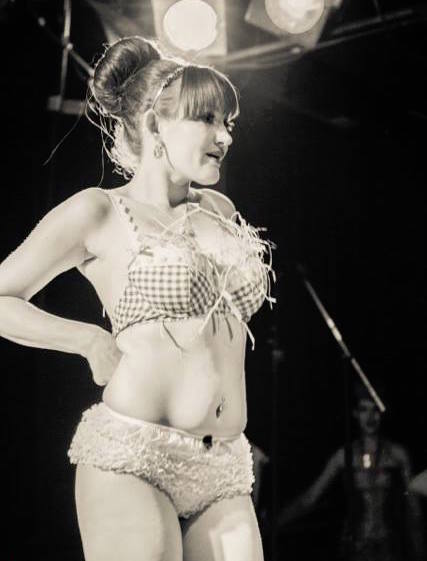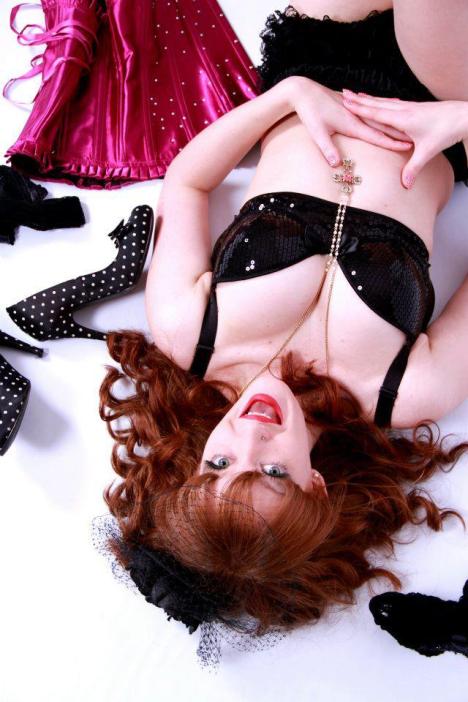Leanne Rice’s boyfriend attacked her in a West Country lane one night six years ago. They had been together for six months, and were already talking about marriage. He was going to join the army, and she would live on base with him once he’d finished his basic training.
However, she was unaware of his drinking problem.
“It was terrifying. I thought I was going to die,” she says.
The incident that night tipped her into a mental breakdown. She stopped eating and stopped going to work. She lost all confidence and her weight fell to seven stone. She became suicidal.
But two years later she was appearing in burlesque shows – first as Ruby Woo, later as Miss Ruby Skies – performing a comedy striptease to The Combine Harvester by The Wurzels.

Leanne Rice performing her Wurzels-inspired routine. (Credit: Camile Photography)
Burlesque may seem like an odd choice for someone suffering from depression and a complete lack of confidence. These are the last people you would expect to want to dance on stage in their underwear in front of a crowd.
But the industry seems to attract people with mental health problems and Leanne, 27, is one of a large number of performers who have used burlesque to help overcome their mental illness.
“I think as a community we’re really open about the realities of suffering with mental health. Most of the performers can relate to it, if not all. It seems to be something we’re connected by,” she says.
Another is Becky Bennett, 30, who performs as Briar Rouge. In her flat in Hitchin she has a cat-shaped chalkboard with one simple message: “Be fucking brave”.
She has had to be. Orphaned at two and bullied at school, she has suffered from depression and bulimia. When she was 24 she was diagnosed with Borderline Personality Disorder, a condition characterised by extreme mood swings and also known as Emotionally Unstable Personality Disorder.

Becky Bennett in her Briar Rouge persona. (Credit: Sharon Moore Photography)
Becky says: “It’s a very erratic condition. I have an extremely addictive and irrational personality. My go-to is always an extreme of something, there’s no middle way with me.
“If something were to upset me, I wouldn’t feel a bit down about it. I get sent into this total, utter state of desperation and despair where I just want to end my life.”
Leanne and Becky arrived at burlesque by different routes. Leanne was introduced to it by a burlesque photographer friend.
“I was looking for things to fill a void and regain some of the confidence I’d lost during this awful time.
“I thought back to the first ever show I had been to and I’d never been able to get out of my mind how amazing and confident and unique those women were.”
A quick internet search found a burlesque course being run by the Foxy Burlesque School near her home in Kent. So, still recovering from her breakdown, she signed up for an eight-week beginner’s course.
Leanne says; “It was the best time. All of a sudden I was in this class with these amazing women from all walks of life. There were mums, there were people with rock bottom confidence, there was someone who’d won a competition.
“I felt like I had nothing else in my life then, and it was the level of brilliantly out there that I think I was looking for.”
Leanne progressed to an intermediate course and then started doing solo performances. For Becky, on the other hand, it was more trial and error.
She had trained as a dancer as a child, but gave it up at 19 after not getting a scholarship to stage school and then falling into an emotionally and physically abusive relationship.
It was about seven years later that she got into burlesque. A friend had hired an instructor for a party and Becky took to it instantly.
“It all just clicked. To actually dance again, move again and perform, it felt amazing.”

Becky Bennett (Credit: Sharon Cooper Photography)
She became friends with the teacher, Gwendoline L’Amour, who mentored Becky through her first months in the industry and her first performance at the Burlesque Idol competition.
But around a year after her first contact with burlesque, she suffered another breakdown.
“I ended up in a really dark place and very much didn’t want to be here, and made an attempt not to be here. It was a really difficult time, but from hitting that low point it got me to realise I did need to accept a bit of help.”
She also made a conscious decision to make burlesque part of her recovery.
Becky says: “I stepped away from burlesque for a while, but I missed performing. In the run up to having this breakdown I’d started doing stuff that was more mainstream, more bookable. But that wasn’t what I wanted to do, so I decided to do what felt right for me.”
What was right for her was something she describes as ‘fairytale burlesque’ – “It’s very ethereal, whimsical. It’s all very pretty and floaty,” she says.
This fairytale element has been one of the key reasons burlesque has helped Becky deal with her mental health problems. It provides some escapism and a link to something that made her happy as a child, when other children would bully her for her appearance and the death of her parents.
“As a kid, I would spend my whole time reading fairytales and watching Disney films and dressing up. That was my little escapism. I was in this rose-tinted world where people lived happily ever after and I threw myself into that.
“Even now, my style of burlesque is very much based on things like that. It’s still my form of escapism now as an adult.
“To be able to get on stage and be all dressed up in a ridiculous sparkling costume with big feather fans, it’s amazing. You become somebody else. You create a stage name, a persona, and that time you’re on stage you don’t have to be you for a little while. You can forget everything.”

Leanne Rice as Miss Ruby Skies (Credit: Camile Photography)
For Leanne, too, burlesque was a way of becoming somebody else, and of correcting things she didn’t like when she was growing up.
She says: “I never fitted in with a popular crowd or a mainstream crowd. I was never fashionable, I was never a particularly pretty teenager. All of these things that I seemed to crave but not have in my teenage years and while I was growing up suddenly came through for me in burlesque.
“I don’t think I’ve ever been happier than travelling home on night buses, covered in glitter in my curtain call dress, and everyone asking what the hell I’ve been doing and who I was.”
Leanne also credits her burlesque persona with helping her regain the confidence she lost six years ago.
“I lived vicariously through Miss Ruby Skies until she became part of me. It’s pretty magical what it does for your-self esteem.
“Once you get on stage you’re hidden behind a mask and you can pull through all of the good bits of your own personality, and the rest you just feign confidence until it wraps itself into being part of you.”
Now Leanne is running her own social media marketing business and has less time for burlesque, which she says left her feeling lost.
“It’s like I’ve lost my purpose a little bit. I genuinely feel like since I stopped burlesque dancing, a part of my personality has fallen away. I miss it more than I could possibly say, but I will go back to it, I will,” she says.

Becky Bennett (Credit: Sharon Moore Photography)
Becky is also performing less due to some physical health problems, but still uses burlesque to escape, floating across stages in her pointe shoes to the Dance of the Sugar Plum Fairy.
She says: “To go on stage and have the audience captured in that moment with you and then have that applause and go backstage and have people tell you ‘Wow, you did a great job Bec’, that feels really good. And that’s why you do it.”

Hi there, you seemed to have used a photo of me (A’dora Derriere) as your banner. It is not credited. Just wondering how you got this photo?
Hi,
I got the photo from Flickr, which said it had a Creative Commons licence. Should it not have been listed as such? I’ll look into the credit thing – not sure how it works with featured images, but I’ll try to get it sorted. Do you know the name of the photographer, just so I can check the Flickr account got it right?